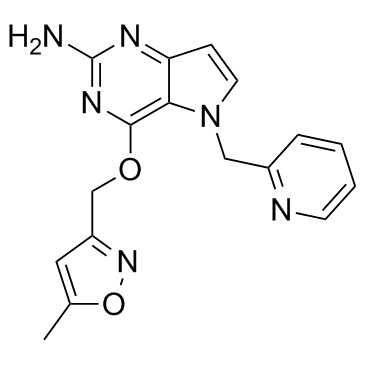| Description |
TLR7-agonist-1 is a potent and selective Toll-like Receptor 7 (TLR7) agonist with a LEC of 0.4 μM.
|
| Related Catalog |
|
| Target |
LEC: 0.4 μM (TLR7)[1]
|
| In Vitro |
TLR7-agonist-1 is a potent and selective Toll-like Receptor 7 (TLR7) agonist with a lowest effective concentration (LEC) of 0.4 μM in HEK293 cell. TLR7-agonist-1 is found to be selective for TLR7 over TLR8 with LEC of >100 μM for human TLR8. TLR7-agonist-1 demonstrates low inhibition across five CYP450 isozymes (IC50 >10 μM) and is also not a time dependent inhibitor of CYP450 3A4. TLR7-agonist-1 has limited inhibition of the hERG potassium ion channel 3H-dofetilide binding in vitro (IC50 >50 μM)[1].
|
| In Vivo |
TLR7-agonist-1 is found to be rapidly cleared in conjunction with our target profile. Both Cmax and AUC increase less than dose proportionally between 0.3 and 3 mg/kg and more than dose-proportionally between 3 and 10 mg/kg. TLR7-agonist-1 can induce an antiviral interferon stimulated gene (ISG) response without inducing an IFNα response at a low dose. TLR7-agonist-1 also induces a 2.7 log decrease in serum HBV viral load from 0.3 mg/kg, and a maximum 3.1 log decrease is observed for doses between 1 and 5 mg/kg[1].
|
| Cell Assay |
The ability of TLR7-agonist-1 to activate human TLR7 and/or TLR8 is assessed by using HEK293 cells. Briefly, HEK293 cells are grown in culture medium (DMEM supplemented with 10% FCS and 2 mM Glutamine). Transfected cells are then detached with Trypsin-EDTA, washed in PBS and resuspended in medium to a density of 1.67×105 cells/mL. Thirty microliters of cells are then dispensed into each well in 384-well plates, where 10 μL of TLR7-agonist-1 in 4% DMSO is already present. Following 6 hours incubation at 37°C, 5% CO2, the luciferase activity is determined by adding 15 μL of Steady Lite Plus substrate to each well and readout performed on a microplate imager. Lowest effective concentrations (LEC) values are determined for TLR7-agonist-1[1].
|
| Animal Admin |
A mouse in vivo model is used to demonstrate the initial proof of concept to induce endogenous IFNα. Single oral administration of 0.3, 1, 3, and 10 mg/kg doses of TLR7-agonist-1 is given to healthy, female, fasted C57Bl/6 mice. Concentrations of TLR7-agonist-1 and mouse-IFN via ELISA are measured from the plasma and compare to vehicle[1].
|
| References |
[1]. McGowan DC, et al. Identification and Optimization of Pyrrolo[3,2-d]pyrimidine Toll-like Receptor 7 (TLR7) Selective Agonists for the Treatment of Hepatitis B. J Med Chem. 2017 Jul 27;60(14):6137-6151.
|
